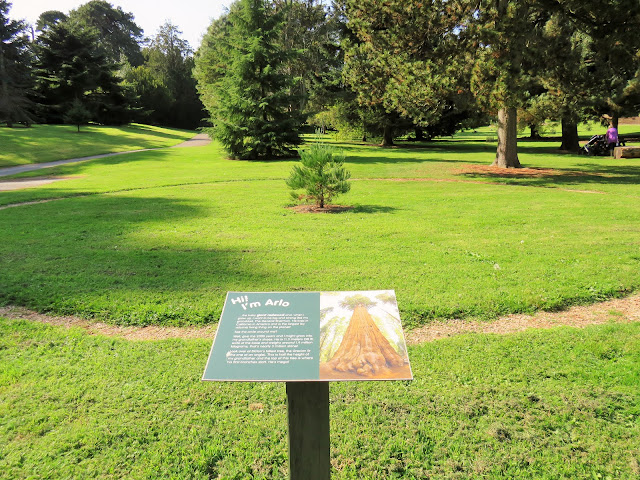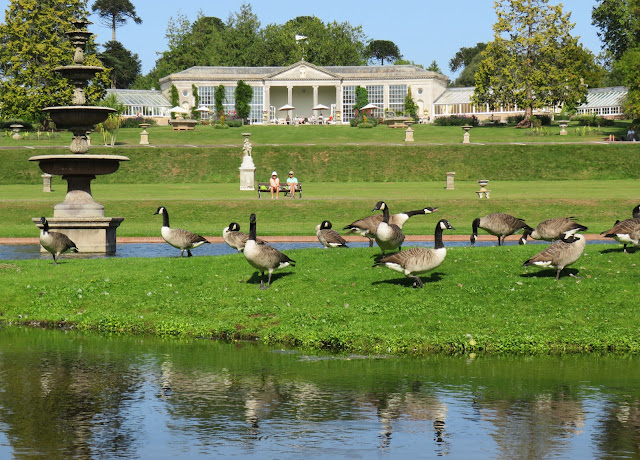Bicton Park Botanical Gardens
Bicton Park Botanical Gardens is a wonderful Heritage garden divided into different interesting sections, each with its own attractions. The garden was established in the late 1700s, although history of the area dates back to the 8th century (originally called Beoccatun - the hamlet belonging to Beocca, a Saxon chieftain who lived in the forest on the west bank of the River Otter). There is a Timeline, tracing 1300 years of Bicton and its estate in the main entrance – which gives visitors a good insight into its fascinating history.
Today, Bicton is home to many rare plants, with origins from all parts of the world, including one of the finest collections of trees in Britain. As well as being a special place for garden enthusiasts to visit, it is somewhere families can enjoy too, with several themed adventure playgrounds as well as them being able to enjoy the Woodland railway (that passes through much of the park).
After entering through the shop, which is always a good place to investigate at the end of the day – you come to an enclosed courtyard (The Garden Centre) with a colourful array of plants for sale, and several greenhouses teeming with bright blooms.
Through an archway in the
wall, you are immediately in the 19th century Rose garden - following on to the Mediterranean Garden, which is full of drought
tolerant plants – such as phormiums and cordylines.
These grow on a sunny slope
overlooking the park’s famous 300 year old Italian Garden with a magnificent blend
of colour and eye catching formality. There is the most amazing view across
terraced lawns, to the huge water feature below - surrounded by trees, statues
and urns.
This part of the garden was
inspired by a French designer who created the gardens at Versailles, and he may
actually have drawn up the original plans here in about 1735.
The symmetrical canals
around the aptly named Mirror Pond were my favourite parts, as the early
morning stillness gave way to some stunning reflections – a truly memorable
sight.
Joining this area is a
wooden walkthrough leading to the American and Stream garden.
This entire area is
surrounded by well stocked flowerbeds – not to mention the ornate ones - filled
with exotic cannas and lilies.
The Church of St Mary can be seen over the far side of the pond, behind huge ancient trees.
The Palm House (the 2nd
largest in Britain even pre-dating Kew’s) was built in the 1820’s, - on a cast
iron frame with over 18,000 panes of glass.
It is such an impressive sight, with its tall central curved, vaulted roof and sloped side wings; and double doors leading out to the colourful garden below. It is one of Bicton’s most beautiful and impressive features - containing a spectacular collection of palms.
Back in the Courtyard you will find the Woodland Railway Station. Bicton’s 18-inch gauge Railway was built in the 1960s as an additional attraction to the park – using decommissioned track from the Royal Arsenal munitions factory on Woolwich.
A scenic ride is an ideal way to appreciate what the park has to offer, and timed tickets need to be purchased when you first arrive at Bicton, to ensure you get a seat. It is the only 18-inch gauge leisure line left in Britain and attracts rail enthusiasts as well as families (and grown-ups wanting to enjoy the thrill a train ride offers).
The “Sir Walter Raleigh” replica engine (named after the 16th-century adventurer, who was born near Bicton), departs from Bicton station several times each day, making a picturesque 25-minute journey. You can enjoy winding through much of the parkland including the Pinetum, with its fabulous collection of trees; until you reach Hermitage Station. Here you begin the return journey, along the edge of the Great Lake – the most delightful little journey of about a mile and a half, that I can highly recommend.
Back at the courtyard area, it is an ideal time to visit the other glass houses with plants from all over the world - living in areas created to resemble their natural habitats.
The Tropical House contains lush foliage and exotic blooms including the famous Bicton Orchid that first bloomed here in 1836.
The Arid House contains some of the world's strangest plants, with cacti and other succulents growing in a desert landscape. And finally, there is the Temperate House – they are full of individual delights.
Follow the upper path, past the Orangery Restaurant and you arrive at an area described as “a primeval rocky glade” full of exotic tree-ferns.
Hidden there is the unusual Shell House, which contains a wonderful collection of seashells from all around the world.
A series of footpaths lead
down from this stone building, through boulders and greenery – eventually
arriving back at the American and Stream Garden which was established in the
1830’s and has some of the loveliest trees and plants from other parts of the
world, such as the Chinese handkerchief tree and Giant Gunnera.
This area contains some of the parks most ornate trees and shrubs, and it is an ideal place for those wanting to enjoy some peace and tranquillity under the shady trees.
The Countryside Museum contains restored artefacts and pieces of machinery from days gone by. The exhibition hall is most deceiving, from the outside it doesn’t look very big – but it is packed with nostalgic delights for all generations.
It contains traction engines, vintage machinery, traditional tools, tractors and domestic memorabilia - following 300 hundred years of history here at Bicton.
In the 1800’s Bicton was a busy estate, and much of what is exhibited here, is what the estates’ employees would have used tending the ornamental and kitchen gardens, as well as in the running of the house and estate – including a 1831 hand-operated fire engine, that has been at Bicton House for 100 years.
The museum really is somewhere that should not be missed – it will be appreciated by young and old alike.
Bicton’s Pinetum and Arboretum, with over 1000 magnificent trees and conifers (at least 300 different types) is another area of the parkland not to be overlooked. It has many rare and endangered species; some of the tallest and largest of their kind in the country - at 134 feet high, the champion Grecian fir is the tallest ever recorded.
This Giant Redwood Tree sapling will grow so big that its truck will be as wide as the outer circle – in maybe 100 years’ time.
Walking through this area of the parkland, if you follow the signs back past the Hermitage Station, you will come to the Fairy Falls – an unusual area that will delight everyone.
Overlooking
this is the Hermitage Garden, a peaceful area in one of the farthest corners of
the park. The forested valley contains colourful camellias and rhododendrons,
bird hives, a nature trail leading back to The Great Lake – an unspoilt area
that doesn’t get too busy.
If the little ones want busy – then Bicton’s indoor Play Barn (Play Zone) is the ideal place to keep them occupied – whatever the weather.
There are also several well-designed outdoor play areas, mini golf, a climbing area, that looks like a pirate ship, and fabulous colourful miniature cottages to have adventures in – or of course they can explore the extensive parkland.
When it is time for a rest and some refreshments, head for the restaurant - which is situated in the 18th Century Temple Orangery overlooking the Italian Garden below. It offers a vast range of options, including drinks and light snacks, as well as a variety of delicious meals. This is accessed through the shop – which is also the best place to browse before heading home.
You can easily spend a whole day at Bicton, exploring and relaxing – in the most perfect surroundings. I thoroughly enjoyed my day and would highly recommend it.
For more information - follow this link - https://www.bictongardens.co.uk/
Thank you for taking the time to follow my adventures,
Lynne
Please check out my other blogs:-














































